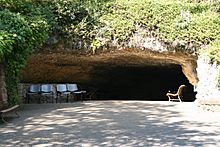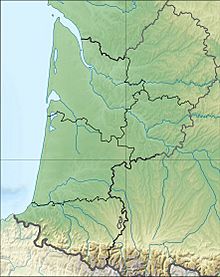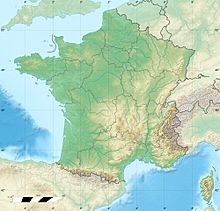Rouffignac Cave facts for kids
|
Grotte de Rouffignac
|
|

Rouffignac Cave
|
|
| Alternative name | Cave of the hundred mammoths, Miremont cave, Cro des Cluzeau, Cro de Granville |
|---|---|
| Location | Rouffignac-Saint-Cernin-de-Reilhac |
| Region | Dordogne, France |
| Coordinates | 45°00′32″N 0°59′15″E / 45.00889°N 0.98750°E |
| History | |
| Cultures | Magdalenian |
| Site notes | |
| UNESCO World Heritage Site | |
| Official name | Cro de Granville (cro de Rouffignac) |
| Part of | Prehistoric Sites and Decorated Caves of the Vézère Valley |
| Criteria | Cultural: (i), (iii) |
| Inscription | 1979 (3rd Session) |
| Area | 51.76 ha (0.1998 sq mi) |
The Rouffignac Cave is a famous cave in France. It's located in a place called Rouffignac-Saint-Cernin-de-Reilhac in the Dordogne region. Inside, you can find more than 250 amazing drawings and carvings made by ancient people during the Upper Paleolithic period.
This cave, along with others in the Vézère valley, is very important. It was named a Monument historique in 1957. Later, in 1979, UNESCO made it a World Heritage Site. This means it's a special place protected for everyone to learn from and enjoy.
Contents
Exploring the Rouffignac Cave
The Rouffignac Cave is also known by other names, like the Cave of the Hundred Mammoths. It sits on a hill near the La Binche river. The rocks that make up the cave are a type of limestone that has lots of flint inside.
The Rouffignac Cave has one of the biggest cave systems in the Périgord area. It has over 8 kilometers (about 5 miles) of underground tunnels! There are also 10 natural shafts that go even deeper. Explorers have found another 4 kilometers (about 2.5 miles) of passages below that.
To see the cave, visitors ride an electric train. This train takes them about 2 kilometers (1.2 miles) deep into the cave. It's a great way to explore this huge underground world.
How the Cave Formed
The cave's passages look a bit like the branches of a tree. Scientists believe the cave started forming about 3 to 2 million years ago. Water slowly seeped into the ground, dissolving the limestone rock. This created the long tunnels and chambers we see today. Now, the cave is mostly dry, except for a small underground stream at its lowest level.
A Look Back in Time: Cave History
The Rouffignac Cave has been known for a long time. Someone named François de Belleforest wrote about its "paintings and animal traces" way back in 1575. In the 1800s, it was already a popular spot for tourists.
Famous archeologists visited the cave in the early 1900s. But it wasn't until 1956 that two experts, Louis-René Nougier and Romain Robert, truly rediscovered the amazing cave art inside. During World War II, the cave even served as a secret hiding place for the French Résistance. The cave officially opened to visitors in 1959.
For a while, some people questioned if the paintings were real. But over time, experts confirmed their authenticity.
Amazing Cave Art
The art in the Rouffignac Cave is mostly made of carvings or black outline drawings. Unlike some other famous caves, like Lascaux, the drawings here don't use many colors. So far, experts have counted 224 animal pictures and 4 human figures.
Most of the animals drawn are:
- 158 mammoths (that's 70% of all the animals!)
- 28 bisons
- 15 horses
- 12 ibex
- 10 woolly rhinoceros
There's also one drawing of a cave bear. Mammoths are clearly the most important animals shown here. You can also see more woolly rhinoceros drawings than in most other ancient caves.
Besides animals, there are also some signs. These include 17 tectiform (house-like) shapes and 6 serpentiform (snake-like) shapes.
A very common type of art here is called finger flutings. These are wavy, macaroni-like lines made by fingers on the soft cave walls and ceilings. They cover a huge area, about 500 square meters (over 5,000 square feet)! In 2011, researchers found that many of these finger flutings were made by children, some as young as three years old! On one ceiling, called Le Grand Plafond, there are 63 animal drawings alone.
Ancient Cave Bears
The Rouffignac Cave was also home to cave bears a long time ago. You can see their scratch marks on the walls. Scientists have also found places where these huge bears used to rest.
How Old is the Art?
It's hard to tell the exact age of the Rouffignac cave art because not many tools or other items have been found inside. However, based on the style of the drawings, experts believe they were made during the Magdalenian period. This was about 13,000 years ago.
Outside the cave entrance, archaeologists have found signs of human activity. They found old campfires, animal bones, and stone tools from the Mesolithic and Neolithic periods. This means that hunters lived near the cave entrance from about 9,200 to 7,800 years ago. They even found tiny, geometrically shaped stone tools called Rouffignac heads. Later, people from the Iron Age also used the area for burials.
Visiting the Cave
The Rouffignac Cave is open to visitors from April 1st to November 1st each year. To protect the cave and its art, only 550 visitors are allowed inside each day.
See also
- Cave of Altamira
- Font-de-Gaume
- Lascaux
- Les Combarelles
Literature
- Leroi-Gourhan, A. (1988). Rouffignac. In: Dictionnaire de la Préhistoire, sous la dir. d'A. Leroi-Gourhan, Presses universitaires de France, Paris, pp. 959–960
- Plassard, Jean (1999). Rouffignac. Thorbecke, Stuttgart. ISBN: 3-7995-9006-4





